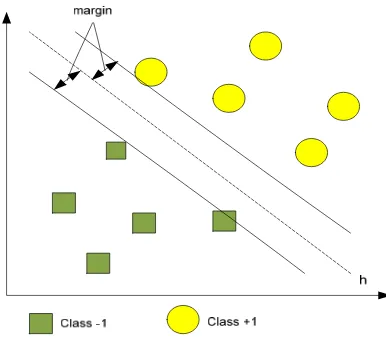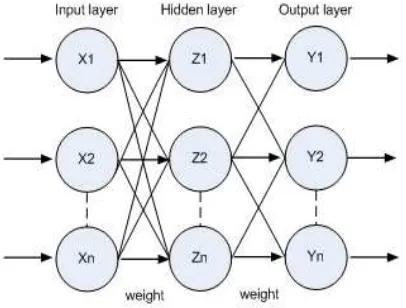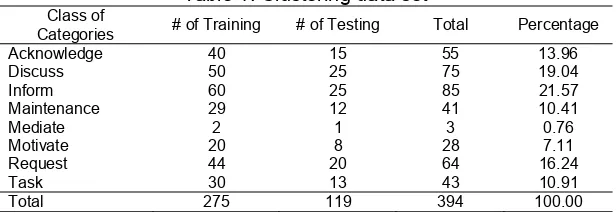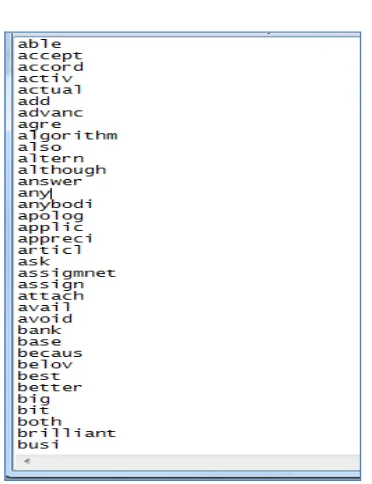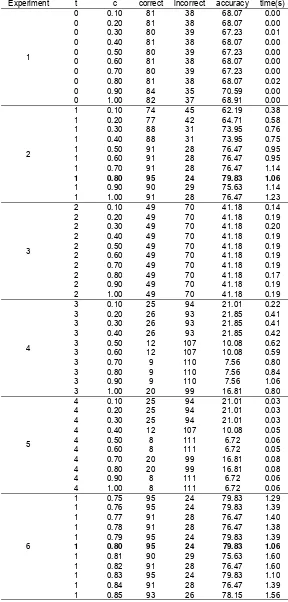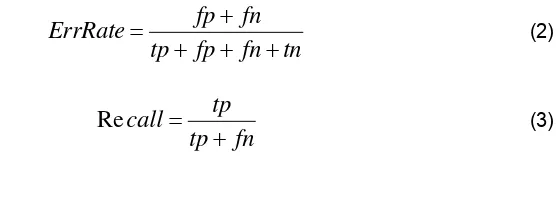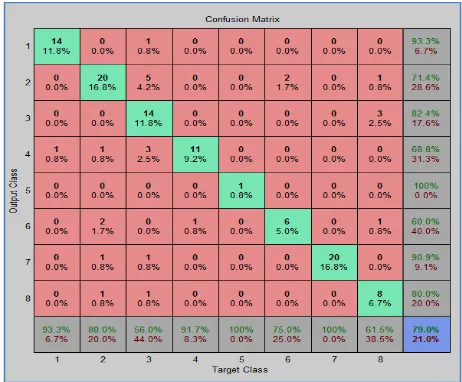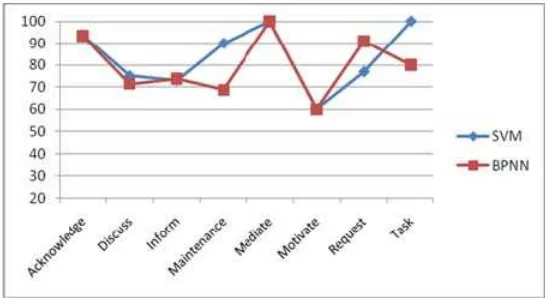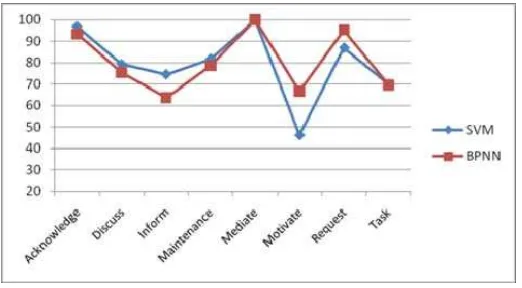DOI: 10.12928/TELKOMNIKA.v12i1.1798 189
Two Text Classifiers in Online Discussion: Support
Vector Machine vs Back-Propagation Neural Network
Erlin*1, Rahmiati2, Unang Rio1
1
Department of Information Technology, STMIK-AMIK Riau, Pekanbaru, 28294, Riau
2
Department of Informatics Management, STMIK-AMIK Riau, Pekanbaru, 28294, Riau *Corresponding author, email: [email protected]
Abstract
The purpose of this research is to compare the performance of two text classifiers; support vector machine (SVM) and back-propagation neural network (BPNN) within categorize messages from an online discussion. SVM has been recognized as one of the best algorithm for text categorization. BPNN is also a popular categorization method that can handle linear and non linear problems and can achieve good result. However, using SVM and BPNN in online discussion is rare. In this research, several SVM data are trained in multi-class categorization to classify the same set with BPNN. The effectiveness of these two text classifiers are measured and then statistically compared based on error rate, precision, recall and F-measure. The experimental result shows that for text message categorization in online discussion, the performances of SVM outperform BPNN in term of error rate and precision; and falls behind BPNN in term of recall and F-measure.
Keywords: text categorization, support vector machine, back-propagation neural network
1. Introduction
Text message categorization is used to assign messages into a certain number of pre-defined categories based on their content. In e-learning environment, especially in online discussion, this interest is one particular aspect of analyzing a message is posted by participant, in which messages should be filed according to content. As the volume of message in online discussion increases and categorize the message into some classes is important, hence, method and technique to automatically categorize the message is needed.
Online discussion presents major challenges to the existing text categorization technique. Online discussion messages are usually incomplete, error-prone, and poorly structured [1]. In online discussion, text categorization that used to classify the message send by student into certain category is often manual, requiring skilled specialists. However, human categorization is not effective way for number of reasons; time-consuming, labour intensive, lack of consistency in category and costly. Therefore, how to use a various computer technologies to auto-coding of message is subject of great research value.
An increasing number of researchers have attempted to produce various machines learning for automating text categorization and classification. For examples, there are Bayesian network classifier [2], decision tree [3], neural network [4], support vector machine [5], fuzzy k -means [6] and maximum entropy models [7]. Gabrilovich and Markovitch [8] have been proved that support vector machine (SVM) is one of the best algorithms for text categorization. Meanwhile, Yu, et al., [9] have argued that neural network (NN) also a popular categorization method that can handle linear and non linier problems for text categorization, and both of linear and non linear neural network classifier can achieve good result. Unfortunately, the use of text classifier in educational setting is rare. Most of text classifiers are used to categorize news article, emails, product reviews and web pages.
2. Description of The Methods 2.1. Support Vector Machine
SVM is one of relatively new method compared with other methods, but has better performance in various application fields such as image processing, handwriting and text classification. Joachims successfully applied SVM to text categorization and achieved an outstanding improvement over other method [5]. He has argued that SVM is appropriate for text categorization because SVM can handle high dimensional feature spaces and few relevant features, which are main properties of text categorization.
The simply concept of SVM can be explained as attempt to find the best hyperplane (h) which is serves as the dividing two classes in the input space. Figure 1 shows the SVM pattern of linearly separable data that has a categorical target variable with two classes. The data is a member of two classes: +1 and -1. Pattern that joined in class -1 symbolized by the green color (boxes), whereas pattern in the class +1, symbolized by the yellow color (circle).
The cases with one category are in the lower left corner and the cases with the other category are in the upper right corner; the cases are completely separated. The SVM analysis attempts to find hyperplane (i.e. a line) that separates the cases based on their target categories. The dashed lines drawn parallel to the separating line mark the distance between the dividing line and the closest vectors to the line. The distance between the dashed lines is called the margin. The vectors (points) that constrain the width of the margin are the support vectors.
Figure 1. SVM pattern of linearly separable data
2.2. Backpropagation Neural Network
Back propagation (or feed-back) networks are called "recurrent" contains feedback connections. Back propagation networks are very powerful and can get extremely complicated [10]. Recurrent networks recalculate previous outputs back to inputs hence; output is determined both by their current input and their previous outputs. It can have signals travelling in both directions by introducing loops in the network. Weight adjustments are made to reduce error. For this reason, backpropagation neural network can be regarded very similar to short term memory in humans in that the state of the network outputs depends: upon their previous input.
is shown in Figure 2. The training of a network by back-propagation involves three stages: the feed forward of the input training pattern, the calculation and back-propagation of the associated error, and the adjustment of the weight and the biases [11].
Figure 2. Three layers BPNN
3. Methodology
In this section, this research discusses how the text categorization method would be classified the message into a certain number of category. In this research, each document represents a message in online discussion. The collaborative learning skill category based on Soller’s model [12] which is modified version of McManus and Aiken’s Collaborative Skills Network [13] is adopted. In Soller’s model each conversation act is assigned a sentence opener indicating the act’s intention. Students communicated through a sentence opener interface by initiating each contribution with one of the key phrases, which conveys the appropriate dialogue intention.
The weakness of sentence opener approach is limitations in using of ideas or thinking that will be delivered in a discussion. Each student communicated by sentence opener first before posting message on the online discussion. Therefore, this research is designed to automated text categorization, hence student feel free to deliver their idea without being limited by the sentence opener that has been set previously by system. We take eight sub-skill categories; request, inform, motivate, task, maintenance, acknowledge, discuss and mediate; to be implemented and tested using SVM and BPNN.
Message of online discussion forum from one subject SCK3433-02 2008/2009: Management of Organisation Information Systems held on Moodle as learning management systems (LMS) in e-learning was examined for one discussion topic. There are 29 students completed the topic of discussion. The total numbers of messages in the online discussion (that are replies to somebody’s message) are 394 messages.
The problem of text categorization may be formalized as the task to approximate an unknown classification function Φ : d × c →Boolean defined as:
otherwise
false
c
ifd
true
c
d
,
,
)
,
(
(1)Where d is a set of document, c is set of categories, for any pair (d, c) of document and category [14]. Text categorization is defined as the process of assigning a Boolean value (true or false) to each pair of a document and its category [15]. In this research, a message that belongs to the specified category is given the Boolean value “true” otherwise, the given to the messages is “false”.
and BPNN cannot be directly interpreted the text. Text or message should first be transformed into a representation suitable for the classification algorithms to be applied.
In order to transform a message into a feature vector that suitable for text classifier, pre-processing is needed. This stage consists of identifying feature by feature extraction and feature weighting. The main goal of feature extraction is to transform a message from text format into a list of words as feature set, easier to be processed by SVM and BPNN algorithms. This step includes tokenization, stop word removal and stemming.
Tokenization is used to separate text into individual words. All upper case characters in the words are converted to lower case characters. Next, stop word removal to remove common words that are usually not useful for text categorization and ignored for later processing such as “are”, “is”, “the”, “a”, etc, based on a stop list for general English text. The remaining words then stemmed using the Porter’s algorithm [16] to normalize words derived from the same root such as “computer”, “computation”, “computing” would end up into the common form “comput”. The result is a list of words based on each message.
Furthermore, we merged the sets of word’s stems from each of the 275 training messages and removed the duplicates. As a result are 1137 terms in the vocabulary is potential as feature set. This research reduced the size of dimension by computing the document frequency (DF). DF is possible to reduce the dimensionality by a factor of 10 with no loss in effectiveness [17]. This seems to indicate that the terms occurring most frequently in the corpus are the most valuable for text categorization. Each message of text is classified in the same category are presumed to have similar meaning and belonging to one of the chosen category.
4. Experiment
Multi-class text categorization is designed to test the performance of SVM and BPNN. Total of 394 messages are split into two parts. First part for training data, we used of 275 messages as training set. Second part for testing data, we used of 119 messages as testing set. Regarding the unbalanced data distribution as shown in table 1, the problem is solved by assigning same proportion on the number of training data and the number of testing data in each class.
Table 1. Clustering data set Class of
Categories # of Training # of Testing Total Percentage
Acknowledge 40 15 55 13.96
Discuss 50 25 75 19.04
Inform 60 25 85 21.57
Maintenance 29 12 41 10.41
Mediate 2 1 3 0.76
Motivate 20 8 28 7.11
Request 44 20 64 16.24
Task 30 13 43 10.91
Total 275 119 394 100.00
Text classifier must be trained before it can be used for text categorization. In order to train the text classifier, a set of training messages and a specification of the pre-defined categories the messages belong to are required. We first need to transform a text into a feature vector representation. Hence the feature extraction is needed. We created a program to combine the three phases of feature extraction in C++ language based on Porter’s algorithm. The result can be seen in Figure 3 that shows a part of list of word after stemming process based on each message.
Figure 3. The part of word after stemming Figure 4. A part list of potential words as feature set
After feature extraction phase that select the important terms, we should do term weighting of each word. There are various term weighting approaches studied in the literature. Boolean weighting is one of the most commonly used. In boolean weighting, the weight of a term is considered to be 1 if the term appears in the message and it is considered to be 0 if the term does not appear in the message.
The size of dimension is reduced by document frequency (DF) method. All potential features are ranked for each category based on the term occurs in the message. The top features for each category are chosen as its feature set. We choose 370 term as text classifier’s input.
Next step, text representation to transform the text into a representation suitable for text classifiers or categorization algorithms to applied. For each training and testing messages, we created the space vectors corresponding to the 275 training messages, where each space vector had a dimensionality of 370.
Training of text classifier based on supervised learning is done by using SVMmulticlass [18] and MATLAB Neural ToolBox [19]. The performance of SVM is very sensitive on the selection of the kernel parameters. The string c is a learning option to determine trade-off training error and margin, and string t is a kernel options to store with the vector. In SVMmulticlass, the value of t
range from 0 to 4. This experiment has done using five values of t (0,1,2,3,4) that combines with the value of c range from 0.10 – 1.0. Hence, these experiments have been completed with all possible value of t paired with all possible value of c. Total six experiments was conducted. Table 2 shows the performance of SVM based on setting of learning option and kernel parameter.
From the table 2 above it can be seen that the best performance when the value of t is 1 and c is 0.80 where the accuracy reaches 79.8 with time processing of 1.06 seconds. Hence, optimal parameter setting used 0.8 as value parameter to c and 1 as value parameter to t.
Table 2. Performance measure of SVM using kernel parameter
Experiment t c correct incorrect accuracy time(s)
1
0 0.10 81 38 68.07 0.00
0 0.20 81 38 68.07 0.00
0 0.30 80 39 67.23 0.01
0 0.40 81 38 68.07 0.00
0 0.50 80 39 67.23 0.00
0 0.60 81 38 68.07 0.00
0 0.70 80 39 67.23 0.00
0 0.80 81 38 68.07 0.02
0 0.90 84 35 70.59 0.00
0 1.00 82 37 68.91 0.00
2
1 0.10 74 45 62.19 0.38
1 0.20 77 42 64.71 0.58
1 0.30 88 31 73.95 0.76
1 0.40 88 31 73.95 0.75
1 0.50 91 28 76.47 0.95
1 0.60 91 28 76.47 0.95
1 0.70 91 28 76.47 1.14
1 0.80 95 24 79.83 1.06
1 0.90 90 29 75.63 1.14
1 1.00 91 28 76.47 1.23
3
2 0.10 49 70 41.18 0.14
2 0.20 49 70 41.18 0.19
2 0.30 49 70 41.18 0.20
2 0.40 49 70 41.18 0.19
2 0.50 49 70 41.18 0.19
2 0.60 49 70 41.18 0.19
2 0.70 49 70 41.18 0.19
2 0.80 49 70 41.18 0.17
2 0.90 49 70 41.18 0.19
2 1.00 49 70 41.18 0.19
4
3 0.10 25 94 21.01 0.22
3 0.20 26 93 21.85 0.41
3 0.30 26 93 21.85 0.41
3 0.40 26 93 21.85 0.42
3 0.50 12 107 10.08 0.62
3 0.60 12 107 10.08 0.59
3 0.70 9 110 7.56 0.80
3 0.80 9 110 7.56 0.84
3 0.90 9 110 7.56 1.06
3 1.00 20 99 16.81 0.80
5
4 0.10 25 94 21.01 0.03
4 0.20 25 94 21.01 0.03
4 0.30 25 94 21.01 0.03
4 0.40 12 107 10.08 0.05
4 0.50 8 111 6.72 0.06
4 0.60 8 111 6.72 0.05
4 0.70 20 99 16.81 0.08
4 0.80 20 99 16.81 0.08
4 0.90 8 111 6.72 0.06
4 1.00 8 111 6.72 0.06
6
1 0.75 95 24 79.83 1.29
1 0.76 95 24 79.83 1.39
1 0.77 91 28 76.47 1.40
1 0.78 91 28 76.47 1.38
1 0.79 95 24 79.83 1.39
1 0.80 95 24 79.83 1.06
1 0.81 90 29 75.63 1.60
1 0.82 91 28 76.47 1.60
1 0.83 95 24 79.83 1.10
1 0.84 91 28 76.47 1.39
1 0.85 93 26 78.15 1.56
error below a predefined level, learning epochs exceeds a predefined number and largest error below a predefined level.
In hidden layer, the number of hidden node affects the generalization performance. Hidden nodes 10, 20, 30 and 40 were tested to find the most appropriate size of hidden node. Each of hidden nodes was tested 20 iterations. While Table 3 shows the best performance, Table 4 shows the average performance of each hidden node.
Table 3. Best performance for four hidden node
#Hidden Nodes Best Performance
Accuracy Epoch Time(s) Error
10 76.80 192 5 0.00991
20 79.00 204 7 0.00977
30 78.80 255 9 0.00998
40 78.20 291 12 0.01000
Table 4. Average performance
#Hidden Nodes Average Performance (20 iteration)
Accuracy Epoch Time(s) Error
10 66.90 413.60 10.55 0.01641
20 75.68 266.85 8.9 0.00988
30 73.83 407.55 13.15 0.01322
40 68.99 583.40 22.45 0.02743
During testing process, the best accuracy for each of four hidden nodes occurs at 19th iteration, 17th iteration, 4th iteration and 9th iteration, respectively.
As can be seen from the tables, accuracy dropped when the number of hidden nodes was less or more then 20. Accuracy was maximized when the size of the hidden layer was 20. We therefore conclude that optimal size of hidden layer should be 20.
This research then has three layers consisting of 370 input nodes, 20 hidden nodes and 8 output nodes. The best BPNN is trained through 1000 epoch with learning rate of 0.1 and momentum 0.7.
5. Experimental Result 5.1. Performance Measure
In order to evaluate a neural network task of collaborative learning skill, we define a contingency matrix representing the possible outcomes of the classification as shown in table 5.
Table 5. Contingency table for binary classification
Category positive (C+) Category negative (C-) Assigned positive (A+) true positive (tp) false positive (fp) Assigned negative (A-) false negative (fn) true negative (tn)
Several measures in the information retrieval and machine learning have been defined based on this contingency table. Recall, precision and F1 measure shown in Eqs. 2, 3 and 4, are
the evaluation measures that have been widely applied for evaluating the performance of text classifiers.
tn
fn
fp
tp
fn
fp
ErrRate
(2)
fn
tp
tp
call
fp
tp
tp
ecision
Pr
(4)
)
(
)
.
(
2
precision
recall
precision
recall
measure
F
(5)In Eqs. (2), (3) and (4), tp (true positive) is the number of documents that are correctly categorized, fp (false positive) is the number of documents that are put into a wrong category, fn
(false negative) is the number of categorized documents that actually belong to no category and
tn (true negative) is the number of documents that are not correctly categorize. In Eq. (5), F is a balanced F-measure, which is a combined measure of precision and recall.
5.2. Comparing the Performance of SVM and BPNN
The experimental results of SVM and BPNN are illustrated in Figure 5 and Figure 6 in 8 by 8 confusion matrix. In this research, confusion matrix C, which is n x n matrix for N-class classifier is used to compute error rate, recall, precision and F-measure.
Figure 5. Confusion matrix of SVM
The confusion matrix gives the number of instances where each digit is correctly classified and also the instances where they are misclassified on using optimization dataset. The row indexes of a confusion matrix correspond to actual values observed and used for model testing; the column indexes correspond to estimated values produced by applying the model to the test data. For any pair of actual/predicted indexes, the value indicates the number of records classified in that pairing. In ideal classifier all entries will be zeroes except diagonal. The sum of the values in the matrix is equal to the number of scored records in the input data table.
There are two values (actual and estimated) for each of category. For instance in confusion matrix of SVM, the first cell (1,1) is the number of actual first category that were predicted to be first category; the value is 15. The second cell (2,2) is the number of actual second category that were predicted to be second category; the value is 21. There are 4 misclassified for second category; 2 of actual second category that were predicted to be third category, 1 of actual second category that were predicted to be sixth category and 1 of actual second category that were predicted to be seventh category.
Comparison performance of SVM and BPNN of eight categories from text of collaborative learning skill in online discussion are summarized in table 6 and table 7. Different category numbers of eight categories may cause diverse performance measures. SVM and BPNN achieved better results in smaller category classes, e.g. Acknowledge, Mediate and Request than larger ones, e.g. Motivate, Task and Inform. The lowest categorization in SVM is motivate category of 37.50%, while in BPNN is Inform of 56%. The performance of most categories is satisfactory. The micro average value of overall recall, precision and F1 measure
rate varied between 78.29% and 83.59%.
Table 6. Performance measure on SVM Classifier
Categories
SVM Error Rate
(%)
Recall (%)
Precision (%)
F-Measure (%)
Acknowledge 0.00 100.00 93.75 96.77
Discuss 16.00 84.00 75.00 79.25
Inform 24.00 76.00 73.07 74.51
Maintenance 25.00 75.00 90.00 81.82
Mediate 0.00 100.00 100.00 100.00
Motivate 62.50 37.50 60.00 46.15
Request 0.00 100.00 76.92 86.95
Task 46.15 53.85 100.00 70.00
Microavg 20.17 78.29 83.59 79.43
Table 7. Performance measure on BPNN
Classifier
Categories
BPNN Error Rate
(%)
Recall (%)
Precision
(%) F-Measure (%)
Acknowledge 6.67 93.33 93.33 93.33
Discuss 20.00 80.00 71.43 75.47
Inform 44.00 56.00 73.68 63.63
Maintenance 8.33 91.70 68.75 78.58
Mediate 0.00 100.00 100.00 100.00
Motivate 25.00 75.00 60.0 66.67
Request 0.00 100.00 90.91 95.24
Task 38.46 61.50 80.00 69.64
Microavg 21.00 82.19 79.76 80.31
Figure 7. Error rate chart for comparison test
In terms of recall, Figure 8 present that SVM outperform BPNN in category of Acknowledge, Discuss and Inform with 100%, 84% and 76%, respectively. SVM falls behind BPNN in category of Maintenance, Motivate and Task with 75%, 37.5% and 53.85%.
Figure 8. Recall chart for comparison test
In terms of precision, Figure 9 shows that SVM outperform BPNN in category of Discuss, Maintenance and Task with 75%, 90% and 100% respectively. SVM falls behind BPNN only in one category; Request with 90.91%.
In terms of F-Measure that is a combined of recall and precision, thus Figure 10 represent that SVM has leading in category Acknowledge, Discuss, Inform, Maintenance and Task. In the category Motivate and Request, BPNN has leading compare to SVM.
Figure 10. F-Measure char for comparison test
6. Conclusion
This research concludes the proven results that SVM and NN can achieve good classification performance of collaborative learning skill in text categorization. This makes this text classifier the best method with a theoretical justification for its use in text categorization. Such a theoretical understanding of learning methods provide the basis for selecting between text classifiers based on prior knowledge. It identifies how methods and tasks differ, so that it can also guide to development of text categorization.
This research also describes how the methods are efficiently implemented in SVMmulticlass and Matlab Toolbox. SVM and NN suitable for training text classifiers with reasonably sized training sets. Furthermore, this research also evaluated the performance and practicability of SVM and NN for learning text classifier. It recognized that solving a learning task is not restricted to simply training the learner, but that pre-processing steps like choosing an appropriate representation are equally important.
The comparison of categorization accuracy has been presented based on error rate, precision, recall, and F-measure. The experimental result shows that one method performed better for some of categories while performing worse in others. In terms of error rate and precision, performances of SVM outperform BPNN and falls behind BPNN in term of recall and F-measure. Comparison in time taken for training and testing, the performance of BPNN is relatively long compared with SVM.
Acknowledgment
This work is supported by Ministry of National Education of the Republic of Indonesia and STMIK-AMIK Riau.
References
[1] Lui AF, Li SC, Choy SO. An evaluation of automatic text categorization in online discussion analysis. Seventh IEEE International Conference on Advanced Learning Technologies. 2007: 205-209.
[2] Lam W, Low KF. Automatic document classification based on probabilistic reasoning: model and
performance analysis. IEEE International Conference on Systems, Man, and Cybernetics,
'Computational Cybernetics and Simulation. 1997: 2719-2723.
[3] Ma L, Shepherd J, Zhang Y. Enhancing Text Clasification using Synopses Extraction. The fourth International Conference on Web Information System Engineering. 2003: 115-124.
[5] Joachims T. Text Categorization with Support Vector Machines: Learning with Many Relevant
Features. 10th European Conference on Machine Learning. 1998: 137-142.
[6] Benkhalifa M, Bensaid A, Mouradi A. Text Categorization using the Semi-Supervised Fuzzy C-means Algorithm. 18th International Conference of the North American Fuzzy Information Processing Society – NAFIPS. 1999: 561-568.
[7] Kazama J, Tsujii J. Maximum Entropy Models with Inequality Constrains: A Case Study on Text Categorization. Machine Learning. 2005; 60(1-3): 159-194.
[8] Gabrilovich E, Markovitch S. Text Categorization with Many Redundant Features: Using Aggressive
Feature Selection to Make SVMs Competitive with C4.5. Proceedings of the 21st International
Conference on Machine Learning. 2004: 321-328.
[9] Yu B, Xu Z, Li C. Latent Semantic Analysis for Text Categorization Using Neural Network. Journal of
Knowledge-Based Systems. 2008; 900-904.
[10] Hamza AA. Back Propagation Neural Network Arabic Characters Classification Module Utilizing Microsoft Word. Computer Science. 2008; 4: 744-751.
[11] Hua LC, Park SC. A Novel Algorithm for Text Categorization using Improved Back-Propagation Neural Network. In: L. Wang et al (Eds); 2006; LNAI 4223: 452-460.
[12] Soller A. Supporting Social Interaction in An Intelligent Collaborative Learning System. Artificial Intelligence in Education. 2001; 12: 40-62.
[13] McManus M, Aiken R. Monitoring Computer-based Collaborative Problem Solving. Artificial Intelligence in Education. 1995; 6(4): 307-336.
[14] Hidalgo JMG. Text Representation for Automatic Text Categorization. Eleventh Conference of the European Chapter of the Association for Computational Linguisitics, EACL. 2003; http://www.conferences.hu/EACL03/
[15] Sebastiani F. Machine Learning in Automated Text Categorization. ACM Computing Survey. 2002; 34(1), 1-47.
[16] Porter MF. An Algorithm for Suffix Stripping. In : Morgan Kaufmann. Readings in Information Retrieval. Morgan Kaufmann Publishers Inc; 1997: 313-316.
[17] Yang Y, Pedersen JO. A Comparative Study on Feature Selection in Text Categorization.
Proceedings of ICML-97. 14th International Conference on Machine Learning. 1997: 412-420.
[18] http://svmlight.joachims.org/svm_multiclass.html
